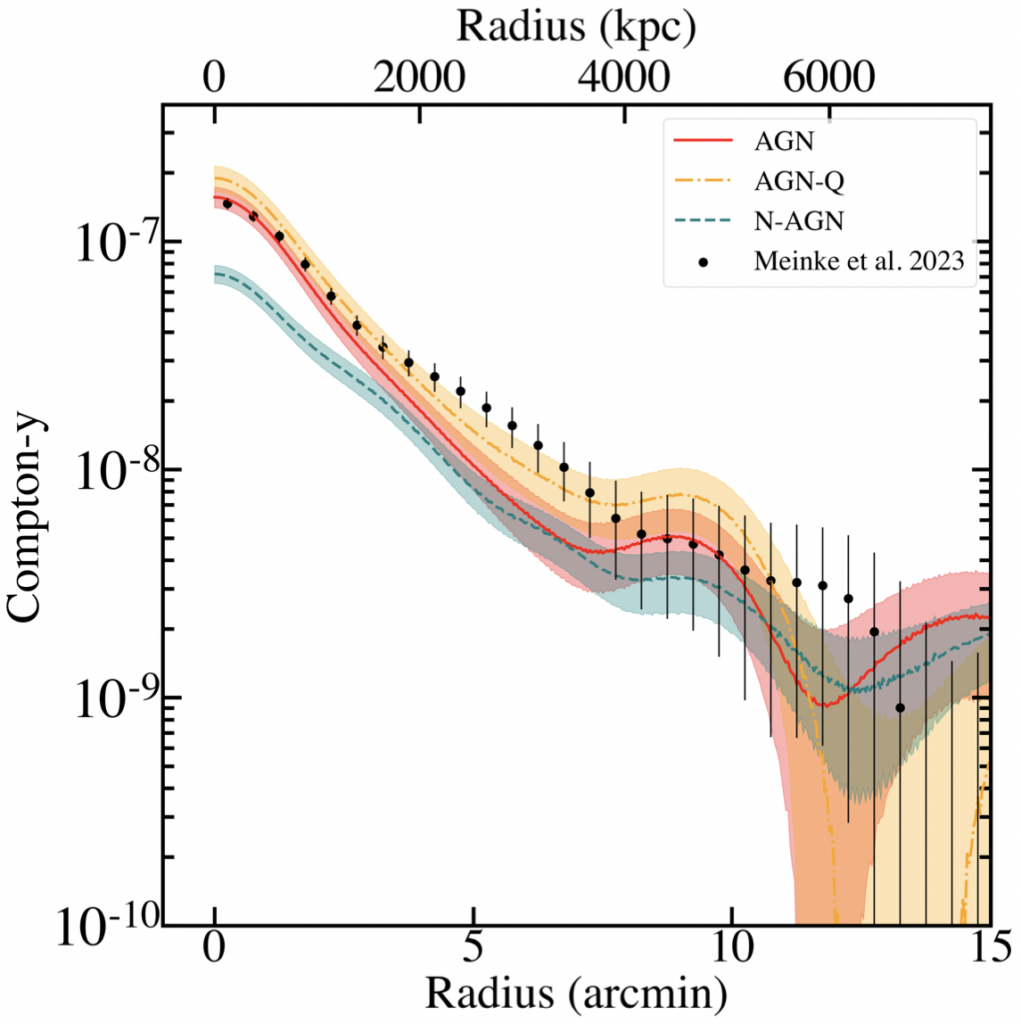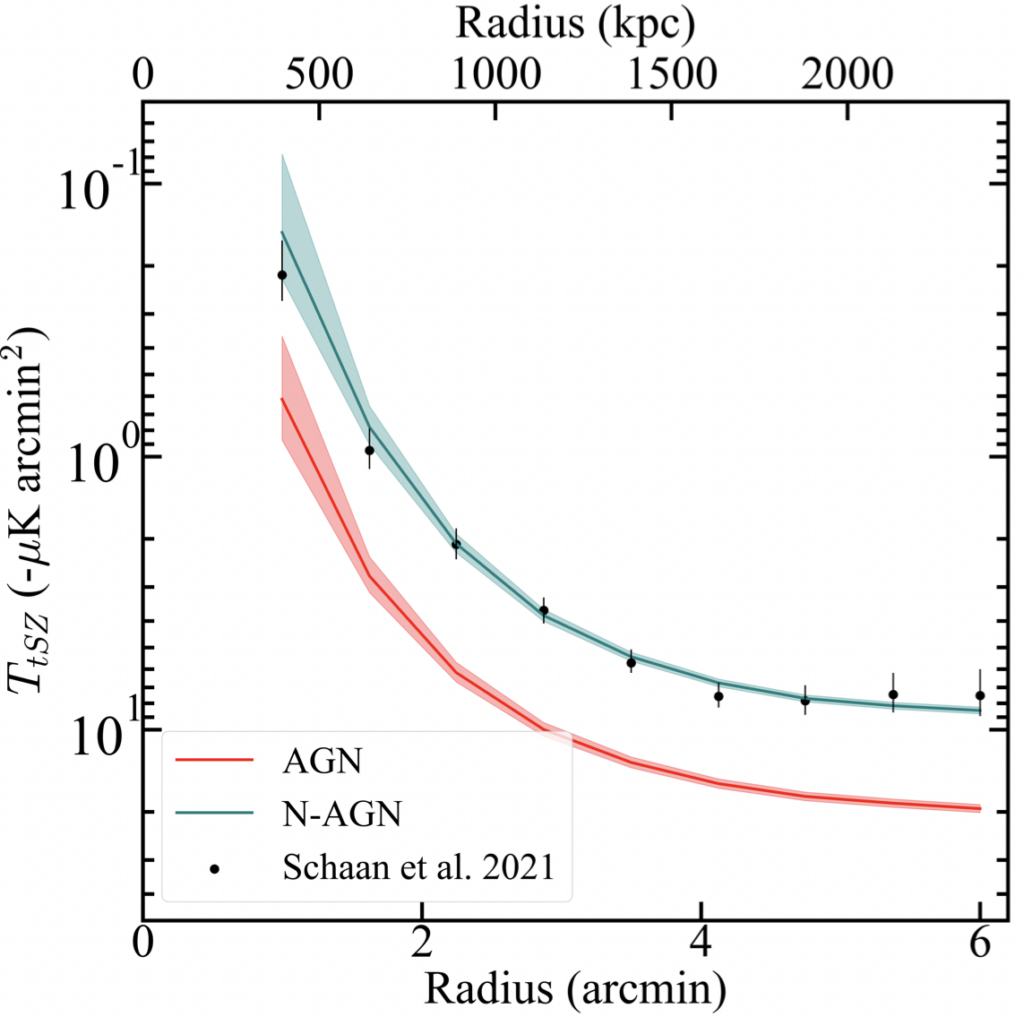Title: Distinguishing AGN Feedback Models with the Thermal Sunyaev-Zel’dovich Effect
Authors: Skylar Grayson, Evan Scannapieco, Romeel Davé
First Author’s Institution: School of Earth and Space Exploration, Arizona State University, P.O. Box 876004, Tempe, AZ 85287, USA
Status: Submitted to the Astrophysical Journal [open access]
Let’s imagine the evolution of the universe as a regular day on Earth. If the Big Bang was when the clock struck midnight, then the “cosmic” dawn is when the first stars and galaxies started to light up our universe. After the cosmic dawn ended, galaxies continued to form stars and grew rapidly throughout the morning. Around “cosmic” noon, most galaxies in our universe were huge and even hosted massive black holes at their centers. However, as the afternoon rolled by, the universe seemed to have gotten pretty lethargic in forming stars and expanding galaxies. Looks like the universe is fond of taking an afternoon siesta!
What caused the rapidly forming galaxies in the universe to suddenly slow down and stop star formation? Why didn’t they continue growing to bigger and bigger sizes? Some astronomers believe this cosmic downsizing is due to feedback from active black holes (also known as Active Galactic Nuclei, AGN). This feedback typically occurs when the black hole spews out fast winds (called outflows) that contain gas and dust and expel it to large distances, sometimes far beyond the galaxy itself. Such outflows can clear the galaxy of any star-forming gas and effectively shut down star formation.
There is still much mystery around how exactly the AGN feedback affects star formation in the galaxy. Nevertheless, various AGN feedback models are often incorporated into simulations of galaxy formation to understand how the universe evolved. This leads to contrasting theories of galaxy evolution, so comparing the simulation feedback models to actual observations of feedback effects is essential to improve our understanding of AGN feedback.
It is hard to directly observe an AGN outflow, as they can be as fast as thousands of km/s and cannot be captured instantaneously. Instead, we can look for indirect evidence. Our universe is filled with a microwave background (CMB), believed to be a remnant of the primordial universe. If we have some high-energy electrons from gas heated by a powerful activity, such as a black hole ejecting material, they would possibly interact with the low-energy photons from the CMB and give it a slight boost. This effect, known as the Thermal Sunyaev Zeldovich (tSZ) effect, is a good clue of a possible AGN feedback episode.
The authors of today’s paper set out to do just that. They compare observations of galaxies with signals from the tSZ effect and signals produced by galaxy simulations with and without AGN feedback. This can help them determine if the simulations correctly model AGN feedback and if this feedback accurately explains the observed cosmic downsizing.
Comparing Simulations vs. Observations
The authors generate maps of the tSZ signal from SIMBA, which is a simulation that explores the co-evolution of galaxies and black holes. They generate one set of maps with galaxies that have AGN feedback and another set with no AGN feedback. They highlight a subsample of galaxies from the former as quiescent or galaxies that have shut down and have no ongoing star formation. There are plenty of such galaxies in the universe, and they are likely there because AGN feedback completely removed all the gas in the galaxy and thus permanently halted star formation.
The tSZ effect from observations can be detected by looking for distortions in the CMB from data collected by radio telescopes (The photons in the CMB have low energies and thus need longer wavelength telescopes to study them). The authors take radio data of a similar sample of galaxies with AGN (including quiescent galaxies) and no AGN. They do this at two different redshifts, z=1 and z=0.5. The authors matched the simulated data with suitable observational effects so they could be compared realistically.
The Compton y-parameter is then used to compare the observed signal to the simulated signal. The Compton y-parameter is defined as the number of scattering times the energy gained per scatter instant and is a commonly used term to characterize scattering in a system. As seen in Figure 1, at z=1, the observed data matches well with the AGN-quiescent model and the AGN model in general and does not line up well with the no-AGN model, indicating that AGN feedback incorporated by the simulation is successful at replicating observed properties at these redshifts.

At z=0.5, the authors compare temperature fluctuations, which also depend on the Compton y-parameter. In doing this, the observed properties replicate the non-AGN model rather than the AGN model (Figure 2). However, this could also indicate that the simulations need to be correctly modeling the AGN feedback. The simulations likely inject too much power into their AGN feedback models at later redshifts, which can harm our understanding of the galaxy properties that it reproduces.

This work highlights the importance of looking for signatures to compare the observations and simulation to improve our understanding of how galaxies evolved, specifically after cosmic noon. The benefits of this are two-fold; one will be to see if the observations agree with our understanding of how it is supposed to evolve, incorporated by the physics in the feedback models. Conversely, it also helps us understand if the simulations are modeling the physics correctly and if any modifications are required in our knowledge of the feedback processes.
Astrobite edited by Jack Lubin
Featured image credit: ESA/Hubble & NASA




